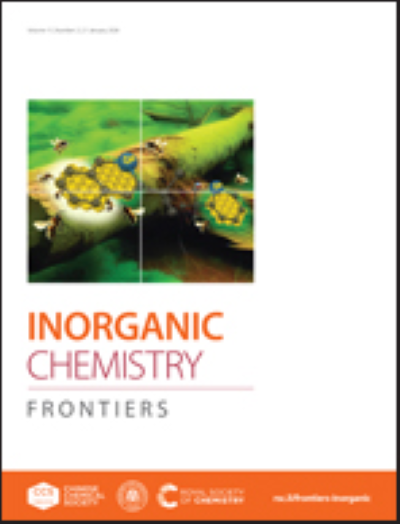用于能量收集的对映体铁(II)有机-无机杂化晶体
IF 6.1
1区 化学
Q1 CHEMISTRY, INORGANIC & NUCLEAR
引用次数: 0
摘要
有机-无机杂化压电材料以其结构可调和固有的机械柔性为特点,在能量收集装置中的潜在应用备受关注。本文介绍了一对Fe(II)掺杂杂化对映体压电材料,设计为(R/ s -3-羟基喹啉)2FeCl4 [(R/S-HQ)2FeCl4]。对映体的压电系数(d33)为21 pC/N,压电电压系数(g33)为408 × 10-3 V m N-1,优于传统的压电聚合物PVDF。此外,(R/S-HQ)2FeCl4具有显著的介电常数开关和优良的循环稳定性。此外,在压电产生装置中,该装置产生的峰对峰输出电压约为2.0 V, 60天后显示的小偏差仅为±0.1 V,证实了长期优异的输出稳定性。这项工作突出了它们在集成到自供电的低压电子设备和能量收集系统方面的巨大潜力。本文章由计算机程序翻译,如有差异,请以英文原文为准。
Enantiomeric Fe(II)-incorporated organic-inorganic hybrid crystals for energy harvesting
Hybrid organic-inorganic piezoelectric materials, characterized by their tunable structure and inherent mechanical flexibility, are garnering significant attention for their potential applications in energy harvesting devices. Herein, we introduce a pair of Fe(II)-incorporated hybrid enantiomeric piezoelectric materials, designed as (R/S-3-hydroxyquinuclidium)2FeCl4 [(R/S-HQ)2FeCl4]. The enantiomers show a piezoelectric coefficient (d33) of 21 pC/N and a high piezoelectric voltage coefficient (g33) of 408 × 10-3 V m N-1, surpassing that of conventional piezoelectric polymer PVDF. Additionally, (R/S-HQ)2FeCl4 demonstrates significant dielectric permittivity switching and excellent cyclic stability. Moreover, in a piezoelectric generation device, this device produces a peak-to-peak output voltage of approximately 2.0 V, and displays a small deviation of only ±0.1 V after 60 days, confirming the long-term excellent output stability. This work highlights their considerable potential for integration into self-powered low-voltage electronic devices and energy harvesting systems.
求助全文
通过发布文献求助,成功后即可免费获取论文全文。
去求助
来源期刊

Inorganic Chemistry Frontiers
CHEMISTRY, INORGANIC & NUCLEAR-
CiteScore
10.40
自引率
7.10%
发文量
587
审稿时长
1.2 months
期刊介绍:
The international, high quality journal for interdisciplinary research between inorganic chemistry and related subjects
 求助内容:
求助内容: 应助结果提醒方式:
应助结果提醒方式:


